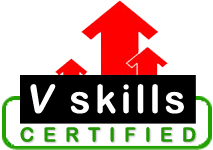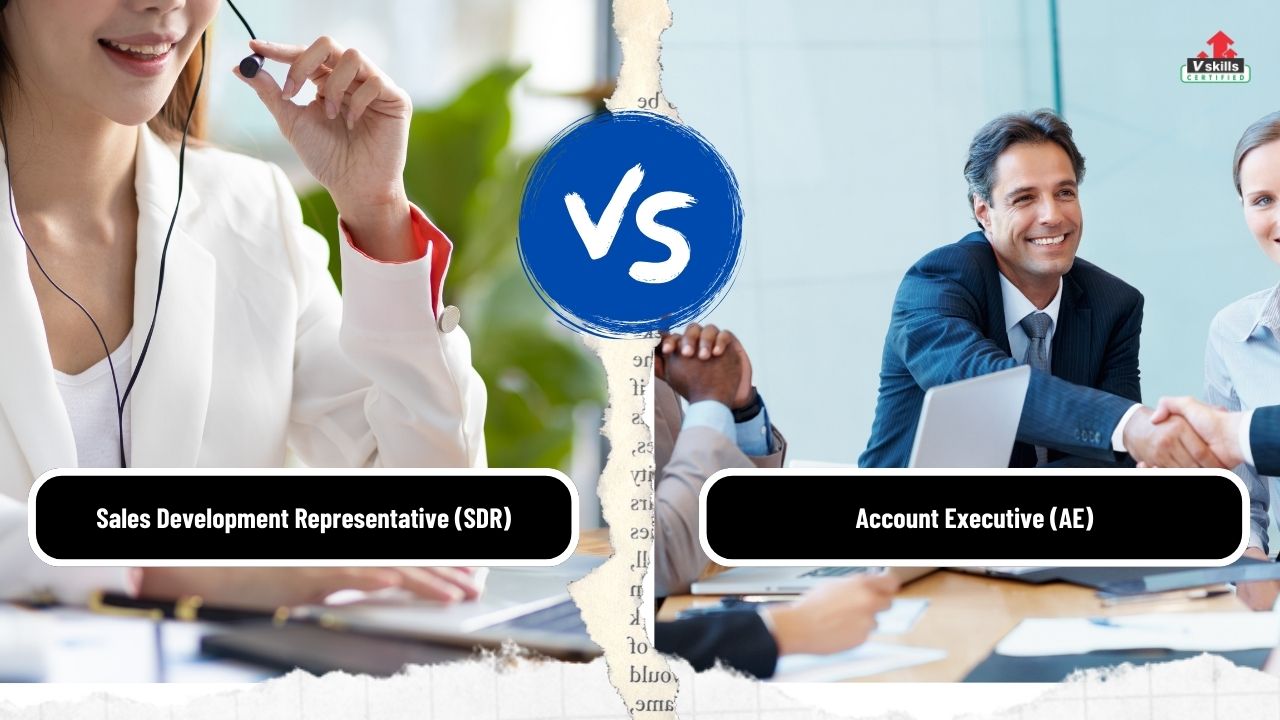Sales is not just about cold calls and closing deals- it covers a very diverse spectrum with multiple career paths, each requiring a unique skill set. So whether you are a natural communicator, a strategic negotiator, or a relationship builder, there is always a sales role that will fit your strengths. It is a journey of success from becoming Sales Development Representative (SDR) to Account Executives (AEs) to Sales Managers and Customer Success Managers, every position plays a crucial role in the sales cycle. But if you are starting or looking to transition, how do you choose the right sales role?
One of the most common career paths begins with a Sales Development role and progresses to an Accounts Executive position. If sales were a high-stakes relay race, Sales Development Representatives (SDRs) and Account Executives (AEs) would be the ultimate dream team. In general, Sales Development Representatives (SDR) are the hunters, tirelessly looking for leads, making cold calls, and setting up golden opportunities. On the other hand, Account Executives are the deal closers, turning those opportunities into signed deals and lasting client relationships. But before you jump into the pool it is very important to understand which role is the right fit for you. Understanding the differences between these two powerhouse roles can help you carve out your ideal path in the fast-paced sales world. So let us break it down!
Sales Development Representatives vs Account Executive: Roles and Responsibilities
In the world of sales, the two wheels driving the engine of revenue generation are – the Sales Development Representative (SDR) and the Account Executive (AE). Consider them as a dynamic power couple, working together to turn potential leads into loyal customers for life. While both play a crucial part in the sales process, their responsibilities, skill sets, and career trajectories are quite different.
- You may say Sales Development Representatives (SDR) are the front-line warriors, focusing on prospecting and lead generation. They are the ones cold-calling, sending emails, engaging on LinkedIn, and qualifying potential clients before handing them off to Accounts Executives. SDRs dont close deals – they just set the stage for success by ensuring that only high-quality leads make it through the pipeline.
- Account Executives, on the other hand, are the dealmakers. Once SDRs identify and qualify leads, AEs take over to pitch, negotiate, and close the sale. They are responsible for conducting demos, addressing objections, managing relationships, and finalizing contracts. Their role is more strategic, requiring a deep understanding of the client’s needs and the ability to convert interest into revenue.
Who is a Sales Development Executive (SDE)?
A Sales Development Representative (SDR) is the first point of contact between a company and potential customers. Their primary responsibility is lead generation and qualification—essentially, they open doors for Account Executives to walk through.
Key Responsibilities of an SDR
- Research potential clients and initiate contact through cold calls, emails, and LinkedIn messages.
- Assess whether a prospect is a good fit based on specific criteria (budget, need, authority, and timeline).
- Schedule meetings or product demos for Account Executives.
- Address common concerns and generate interest in the company’s product or service.
- Keep track of interactions, follow-ups, and lead status in a CRM system.
Skills Needed to Succeed as an SDR
- Strong communication and persuasion skills.
- High resilience and persistence (handling rejection is part of the job).
- Solid research and analytical abilities to identify promising leads.
- Ability to work with sales tools and CRM platforms like Salesforce or HubSpot.
An SDR role is often an entry point into sales, with many professionals transitioning into Account Executive (AE) positions after gaining experience. Strong performance in an SDR role can also lead to opportunities in sales leadership, marketing, or customer success.
Who is an Account Executive (AE)?
An Account Executive (AE) is responsible for closing deals and turning qualified leads into paying customers. While SDRs focus on filling the sales pipeline, AEs handle the actual sales process, from presenting solutions to negotiating contracts.
Key Responsibilities of an AE
- Showcase products or services to potential clients.
- Understand client needs and nurture long-term partnerships.
- Overcome objections, finalize pricing and secure contracts.
- Work closely with SDRs to ensure high-quality lead handoff.
- Track opportunities, forecast revenue, and meet sales targets.
Skills Needed to Succeed as an AE
- Strong negotiation and persuasion skills.
- Excellent relationship-building abilities.
- Ability to handle pressure and meet sales targets.
- Deep product knowledge and problem-solving skills.
Successful AEs often move into Senior Account Executive, Sales Manager, or Sales Director roles. Some may also shift into enterprise sales, business development, or strategic partnerships.
Sales Development Representative (SDR) vs Account Executive: Key Differences
| Category | Sales Development Representative (SDR) | Account Executive (AE) |
|---|---|---|
| Main Focus | Finding & qualifying leads | Closing deals & managing clients |
| Daily Activities | Cold calls, emails, outreach | Sales presentations, negotiations |
| Success Metrics | Meetings booked, lead conversion rate | Revenue closed, deal size |
| Required Skills | Research, persistence, communication | Negotiation, relationship management |
| Compensation | Base salary + smaller commission | Higher base salary + bigger commissions |
| Career Path | Transition to AE or leadership roles | Move up to Sales Manager, Director, VP |
Which Role is Right for You?
You might be a great fit for an SDR role if you:
- Enjoy fast-paced, high-energy environments.
- Love networking and engaging with new people.
- Handle rejection well and stay motivated.
- Want an entry point into sales with room for growth.
You might be a great fit for an AE role if you
- Prefer deep conversations and building long-term relationships.
- Thrive in high-pressure situations with revenue targets.
- Have strong negotiation and problem-solving skills.
- Enjoy closing deals and driving revenue growth.
Both SDRs and AEs are essential to a company’s sales success. If you’re new to sales, starting as an SDR can be a great way to develop foundational skills before advancing into an AE role. If you already have experience in sales and enjoy closing deals, an AE position might be the perfect fit.
Key Performance Metrics for SDRs & AEs: How Success is Measured?
Both Sales Development Representatives (SDRs) and Account Executives (AEs) play critical roles in the sales process, but their success is measured differently. SDRs are evaluated on their ability to generate and qualify leads, while AEs are judged based on their ability to convert those leads into revenue. Below, we wll break down the key performance metrics for both roles.
Key Performance Metrics for Sales Development Representatives (SDRs)
SDRs operate at the top of the sales funnel, focusing on prospecting, outreach, and lead qualification. Their performance is measured based on activity levels, lead quality, and conversion rates.
Activity-Based Metrics (Quantity & Efficiency)
These metrics measure the volume of outreach SDRs perform to generate leads.
- Outbound Calls Made: Number of calls made daily/weekly.
- Emails Sent: Number of emails sent to prospects.
- LinkedIn & Social Outreach: Messages and interactions with potential leads on LinkedIn or other platforms.
- Talk Time (Call Duration): Average time spent speaking with prospects (shows engagement).
- Higher activity levels increase the likelihood of finding qualified leads.
Lead Generation & Qualification Metrics (Quality & Conversion)
These metrics evaluate how well SDRs identify and qualify potential leads before passing them to AEs.
- Leads Generated: Total number of leads sourced.
- Lead Response Rate: Percentage of prospects who respond to outreach.
- Meetings Booked (Appointments Set): Number of discovery calls scheduled with AEs.
- Lead Qualification Rate: Percentage of leads that meet qualification criteria (Budget, Authority, Need, Timing—BANT).
- Conversion Rate (Lead-to-Opportunity): Percentage of leads that turn into real sales opportunities.
- These metrics ensure SDRs are not just reaching out but also engaging high-quality prospects.
Pipeline & Efficiency Metrics (Impact on Revenue)
These metrics track how SDRs contribute to the overall sales pipeline.
- Pipeline Value Generated: Estimated revenue from SDR-sourced leads.
- Sales Accepted Leads (SALs): Leads passed to AEs that meet sales criteria.
- Sales Qualified Leads (SQLs): Leads that move further into the sales pipeline.
- Shows the direct impact SDRs have on potential revenue.
Performance & Effectiveness Metrics
- Follow-up Rate: Measures consistency in reaching out to prospects multiple times.
- No-Show Rate: Percentage of scheduled calls that don’t happen (indicates lead quality).
- Time to First Response: How quickly an SDR responds to inbound leads.
- The faster and more effective an SDR is, the more likely they are to drive results.
Key Performance Metrics for Account Executives (AEs)
AEs operate at the bottom of the sales funnel, focusing on closing deals, revenue generation, and account management. Their performance is measured based on revenue impact, deal efficiency, and customer success.
Revenue & Sales Metrics (Bottom-Line Impact)
These are the most critical performance indicators for AEs.
- Closed Deals (Win Rate): Number of deals successfully closed.
- Revenue Closed: Total sales revenue generated.
- Average Deal Size: Average contract value per deal.
- Quota Attainment: Percentage of sales target achieved.
- Sales Cycle Length: Average time taken to close a deal.
- These metrics directly impact a company’s bottom line and determine an AE’s earning potential (commission, bonuses, promotions).
Pipeline & Conversion Metrics (Sales Funnel Performance)
- Lead-to-Customer Conversion Rate: Percentage of leads that turn into paying customers.
- Proposal-to-Close Rate: Percentage of proposals that result in signed contracts.
- Pipeline Coverage Ratio: Ratio of pipeline value to quota (ensures enough leads are in progress to meet targets).
- These metrics measure how efficiently AEs convert potential opportunities into revenue.
Relationship Management & Retention Metrics (Long-Term Success)
- Customer Retention Rate: Percentage of customers who renew contracts.
- Upsell & Cross-Sell Revenue: Additional revenue generated from existing customers.
- Customer Lifetime Value (CLV): Total revenue expected from a client over time.
- Churn Rate: Percentage of customers lost after onboarding.
- Shows an AE’s ability to build trust and long-term client relationships.
Sales Efficiency & Effectiveness Metrics
- Call-to-Close Ratio: Number of calls needed to close a deal.
- Demo-to-Close Rate: Percentage of product demos that lead to sales.
- Objection Handling Success Rate: Percentage of objections successfully resolved.
- AEs who improve efficiency close more deals in less time.
SDR vs. AE: Performance Metric Comparison
| Metric Type | SDR Focus | AE Focus |
|---|---|---|
| Activity-Based | Outreach volume (calls, emails, LinkedIn) | Sales presentations, follow-ups |
| Lead Generation | Leads generated, qualification rate | Lead-to-customer conversion rate |
| Pipeline Metrics | Pipeline value from sourced leads | Pipeline-to-quota ratio, deal size |
| Revenue Impact | Indirect (setting up deals) | Direct (closing revenue) |
| Efficiency Metrics | Follow-up speed, response time | Sales cycle length, deal close rate |
| Relationship Metrics | Initial engagement, appointment setting | Customer retention, upsells |
Understanding these key performance metrics can help both SDRs and AEs improve their performance, track progress, and advance in their sales careers.
How SDRs Transition to Account Executives
If you are an SDR looking to level up or just starting your sales career and wondering about long-term growth, this section is for you. Transitioning from a Sales Development Representative (SDR) to an Account Executive (AE) is a common and achievable career move – but it requires strategy, skill-building, and persistence. Let’s break down how you can make that leap and even go beyond.
Transitioning from Sales Development Representative (SDR) into Account Executive (AE) Roles
Moving from SDR to AE will not happen automatically, it needs to be earned. Since AEs handle closing deals rather than lead generation, companies look for SDRs that consistently demonstrate strong sales fundamentals. Here’s how to position yourself for the promotion:
- Consistently Exceed Your SDR Metrics – High-quality leads, meetings booked, and pipeline contributions show your readiness.
- Shadow Top AEs – Learn their process for handling objections, negotiating, and closing deals.
- Ask for Closing Opportunities – Some companies allow SDRs to co-sell or assist AEs—grab the chance!
- Master Product & Market Knowledge – Understand the industry, competitors, and pricing models inside out.
- Develop Strong Sales Communication – Improve storytelling, active listening, and persuasion.
- Express Your Career Intentions – Let your manager know you’re aiming for an AE role so they can guide you.
Key Skills to Develop for Career Growth
As an SDR, you are great at opening conversations. AEs, however, must navigate objections, negotiate terms, and finalize deals. Work on:
- Objection Handling: Learn how to turn “No” into “Yes” through problem-solving.
- Negotiation Skills: Understand pricing discussions and contract terms.
- Sales Presentations: Learn how to deliver high-impact product demos and pitches.
AEs handle multiple deals at different stages. Master:
- Prioritization: Focus on high-value prospects.
- Follow-ups & Nurturing: Keep deals moving without being pushy.
Emotional Intelligence (EQ) & Resilience: Sales is a rollercoaster. The best AEs stay calm, confident, and persistent even after rejection.
Quick Quiz: Are You a Natural Prospector or a Closer?
- Do you love researching, engaging with new people, and crafting the perfect cold email? → You might be an SDR
- Do you enjoy building long-term relationships, handling objections, and negotiating deals? → AE could be your calling.
- Do you get energized by quick wins and rapid outreach? → SDR
- Do you thrive in high-stakes conversations that require persuasion? → AE
- Do you enjoy detailed conversations about business needs and budgets? → AE
- Are you great at keeping track of follow-ups and generating new leads? → SDR
Career Opportunities & Growth Potential
A career in sales offers immense growth potential, high-earning opportunities, and leadership prospects. Whether you start as a Sales Development Representative (SDR) or an Account Executive (AE), both roles provide clear pathways for career advancement—eventually leading to management and executive-level positions.
SDR Career Path & Growth Potential
Starting as an SDR is a great way to enter the sales world. It builds foundational sales skills, including lead generation, prospecting, and outbound sales. The natural next step is transitioning into an AE role, but there are multiple paths you can take.
- SDR → Senior SDR
- After one to two years of experience, top-performing SDRs often get promoted to a Senior SDR role with added responsibilities like mentoring junior SDRs and handling larger accounts.
- Senior SDR → Account Executive (AE)
- With consistent performance and skill-building in objection handling and negotiation, SDRs can transition to an AE role, where they manage and close deals.
- AE → Sales Manager → VP of Sales
- AEs who prove their ability to close deals efficiently can grow into Sales Managers, leading teams of SDRs and AEs.
- From Sales Manager, the next step is becoming a Director or VP of Sales, overseeing company-wide revenue strategies.
Alternative Path: SDRs can also move laterally into Business Development or Account Management roles, leading to leadership positions in customer success or corporate partnerships.
AE Career Path & Growth Potential
For those who start as an AE or transition from an SDR role, the career path can lead to higher-level sales positions with greater responsibilities and earning potential.
- AE → Senior AE
- Experienced AEs who consistently meet or exceed sales targets often get promoted to Senior AE roles. These positions come with larger deal sizes and higher quotas.
- Senior AE → Enterprise Sales or Strategic Accounts
- Top-performing Senior AEs often transition to handling large enterprise accounts, which involve multi-million-dollar deals and long-term client relationships.
- Enterprise Sales → Sales Director → Chief Revenue Officer (CRO)
- Sales professionals who excel at closing high-value deals can grow into leadership roles such as Sales Director, VP of Sales, or Chief Revenue Officer (CRO), where they drive revenue strategy for an entire organization.
Expected Salaries in India for SDRs and AEs
Salaries in sales vary based on experience, industry, and company size. However, a combination of base salary and commissions makes sales one of the most lucrative career paths.
SDR Salary in India
- Entry-Level SDR: ₹3-5 LPA
- Senior SDR: ₹6-9 LPA
- SDR Manager: ₹10-15 LPA
AE Salary in India
- Entry-Level AE: ₹6-10 LPA
- Senior AE: ₹12-18 LPA
- Enterprise Sales AE: ₹20-30 LPA
- Sales Director: ₹35-50 LPA
- VP of Sales/CRO: ₹50 LPA and above
Commissions and performance-based bonuses can significantly increase earnings, especially for AEs and sales leaders. Many top-performing sales professionals earn double their base salary through incentives.
Choosing the Right Sales Path
Both SDR and AE roles offer strong career growth, but the right choice depends on individual strengths and long-term goals. SDRs develop skills in outreach and lead generation, while AEs focus on deal closing and client relationship management. Regardless of where you start, both paths can lead to executive roles in sales leadership.
Both SDR and AE roles serve as stepping stones to a rewarding career in sales, each offering unique challenges and opportunities. If you thrive on building relationships, identifying potential customers, and setting the stage for deals, an SDR role is an excellent starting point. If you prefer negotiating, closing deals, and managing client relationships, the AE path may be the right fit.
No matter where you begin, sales is a field driven by performance, skill development, and continuous learning. With the right mindset, dedication, and strategic career moves, you can progress from an entry-level sales role to senior leadership positions. Now is the time to assess your strengths, set your career goals, and take action. Consider investing in sales training, networking with industry leaders, or finding a mentor to accelerate your growth. The path to success in sales is yours to shape.




